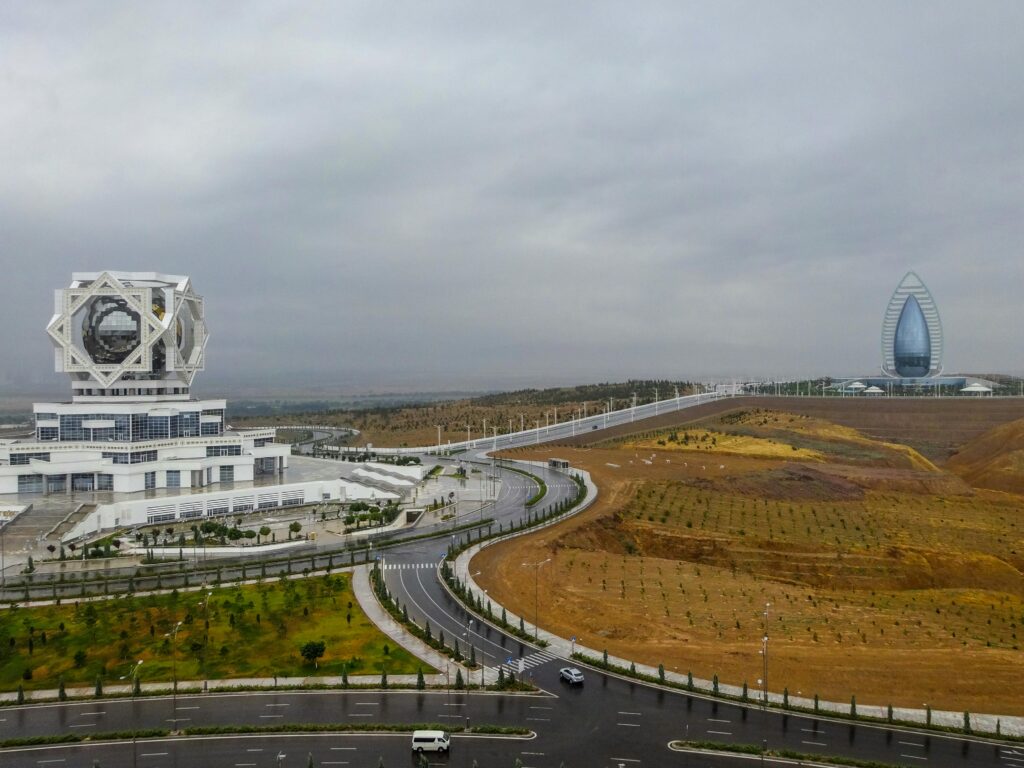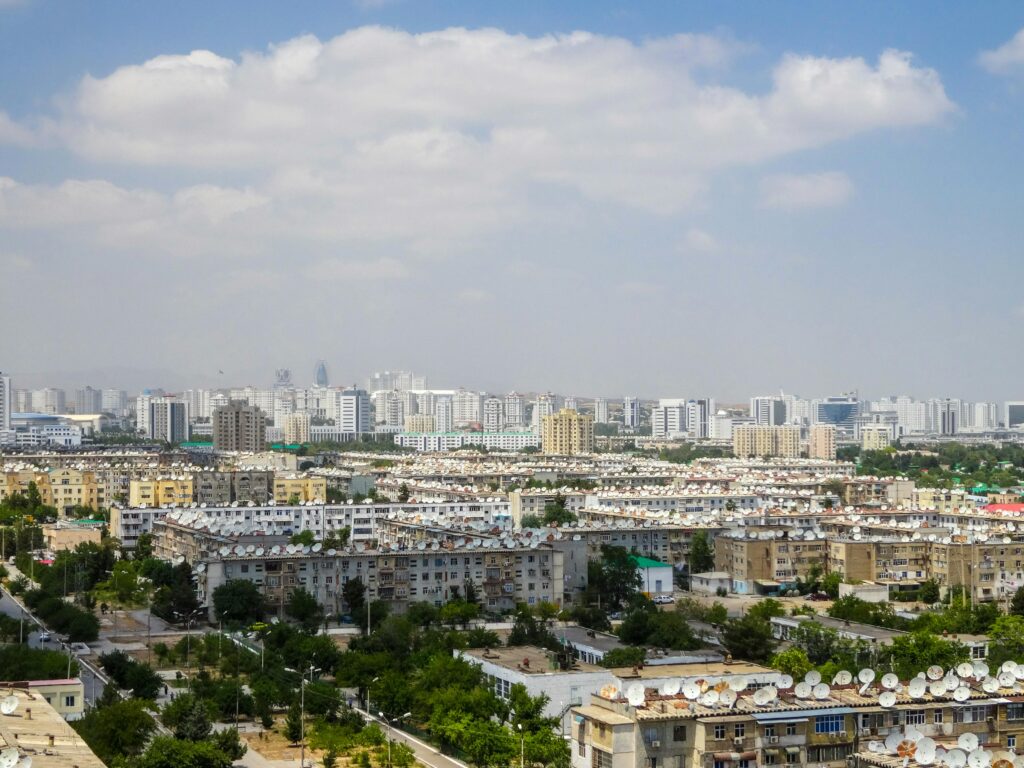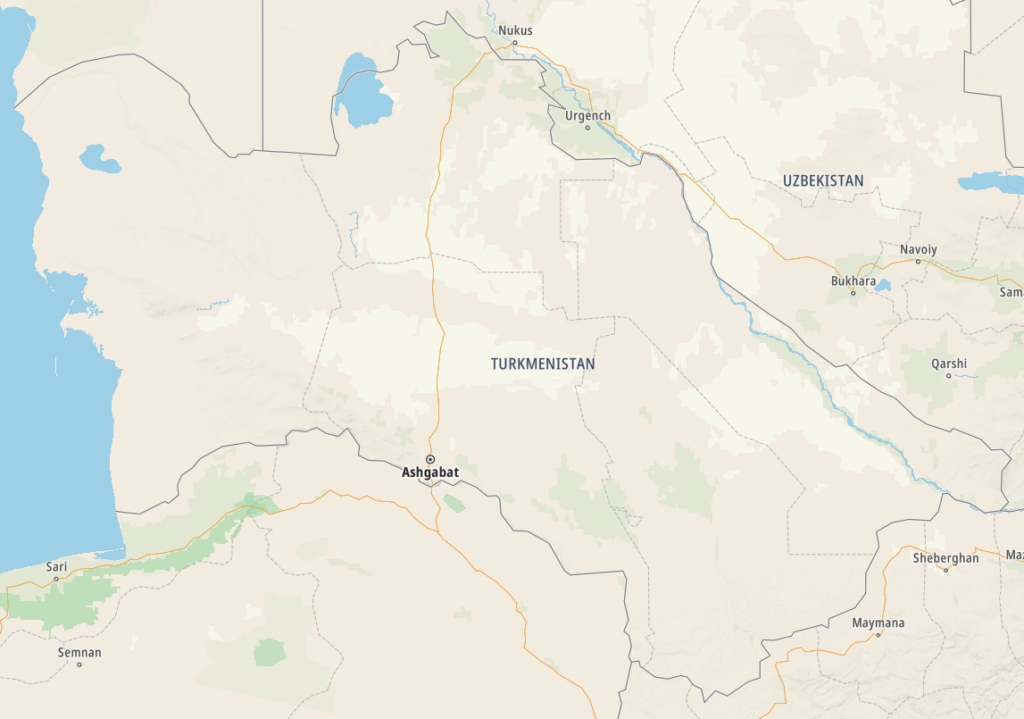Turkmenistan / Türkmenistan – Let’s explore here

What’s it like in Turkmenistan?
Turkmenistan is a very hot and dry, landlocked country in central Asia. It’s about the size of Spain, and mainly consists of desert, rising to mountains at the Iranian border. The highest point is Mount Ayribobo, at 10,295 ft (3,138 m) above sea level, in the south east of the country, on the border with Uzbekistan.
It has a very long, rich and interesting history. In former times it was a major trading and stopping point for those on the Silk Road. Its neighbours include Afghanistan, Kazakhstan, Iran and Uzbekistan.
The population of Turkmenistan is around seven million people (2022), with about one million living in the capital, Ashgabat. Turkmenistan has a young population, with around on in four being under thee age of 15 years.
It relies heavily on its oil and gas reserves. In summer it reaches very high temperatures, be aware!

A bit about the history of Turkmenistan
Early History
Turkmenistan has a long history influenced by various empires and civilisations. The region was home to several ancient cultures, including the Parthian Empire, which ruled from the 3rd century BC to the 3rd century AD. It later became part of the Sassanian Empire and was influenced by the spread of Islam in the 7th century.
Rule of the Mongols and the Timurid Empire
In the 13th century, the Mongols under Genghis Khan invaded the region, and Turkmenistan became part of the Mongol Empire. After the decline of the Mongols, the area was incorporated into the Timurid Empire in the 14th century under the leadership of Timur (Tamerlane). The region became a key area for trade, especially along the Silk Road.
Russian Imperial Expansion
In the 19th century, the Russian Empire expanded into central Asia, and Turkmenistan became part of Russian territory after a series of military campaigns in the region. The Russian colonisation led to the establishment of the Turkmen region within the Russian Empire and later the Soviet Union. During this time, many traditional nomadic practices were disrupted, and the region underwent significant changes.
Soviet Period
In 1924, Turkmenistan became one of the Soviet republics, known as the Turkmen Soviet Socialist Republic. During this period, the country underwent industrialisation and agricultural collectivisation, while the Soviet government imposed strict controls on culture and religion. Although there was some modernisation, many ethnic Turkmen traditions were suppressed.
Independence
Following the collapse of the Soviet Union in 1991, Turkmenistan declared its independence. Saparmurat Niyazov, the country’s first president, became the dominant figure in the newly independent nation. He introduced a personality cult, ruling with authoritarian methods and implementing policies to strengthen his power.
Post-Independence Era
Since independence, Turkmenistan has maintained a highly centralised government under the control of its president. The country has been rich in natural gas resources, which has been a key driver of its economy. Despite the wealth generated by these resources, Turkmenistan remains one of the most authoritarian and isolated countries in the world, with limited political freedoms and a lack of democratic processes.
Recent Developments
In recent years, Turkmenistan has sought to diversify its economy and improve its international relations, though it remains cautious about opening up to the outside world. The country has begun to explore greater participation in regional trade agreements and infrastructure projects. However, the political environment remains tightly controlled, and the president’s influence continues to dominate the country’s affairs.

Turkmenistan road trip
Due to the land border issue in Azerbaijan (see our blog), it’s unsure whether we will visit Turkmenistan and the Stans in the short term. It may be that we visit them from the other direction (i.e. from China), once we’ve travelled up through the Americas. As such, we do not have a defined itinerary for visiting Turkmenistan.
However, if the land border does open, we hope to travel across Kazakhstan, Uzbekistan, Turkmenistan, Tajikistan, Kyrgyztan and back through Kazakhstan. Hopefully this journey will improve our knowledge of this intriguing and beautiful country, and enable us to meet some interesting people. We’ll be updating this page at that time – don’t forget to check back 🙂
Map of Turkmenistan

What’s it like to drive in Turkmenistan?
They drive on the right hand side of the road in Turkmenistan. In the main, roads are very poor, with many being unsurfaced dirt tracks. Driving standards are also poor.
You’ll be charged up to US$150 to bring a car into Turkmenistan by land or sea.
Do you require an international driving permit in Turkmenistan?
We’ve created a dedicated page to driving abroad, which answers this question, and more, which you might find helpful.
Can you use your UK driving license when driving through Turkmenistan?
We’ve created a dedicated page to driving abroad, which answers this question, and more, which you might find helpful.
Do I need a carnet de passages to drive in Turkmenistan?
We’ve created a dedicated page to driving abroad, which answers this question, and more, which you might find helpful.
What currency do they use in Turkmenistan?
In Turkmenistan they use the Turkmenistani mana. Cash is widely used. The use of credit / debit cards is not widely accepted outside of the capital, Ashgabat. Travellers cheques are not accepted at banks. There are a few ATMs in all major cities now and in some towns, however foreign issued cards are not accepted. Dollars and sometimes Euros can be accepted for many purchases.
You should make yourself aware of the amount that your bank charges you for using credit and debit cards abroad. Often credit cards are cheaper for purchasing items directly, and for withdrawing cash from ATMs.
What language do they speak in Turkmenistan?
They speak Turkmen in Turkmenistan, and many also speak Russian in Ashgabat. English is not widely spoken outside of, or even inside the capital.
What time zone is Turkmenistan in?
Remember, when you’re planning your next trip to take a look at what time zone it’s in.
Do I need a visa to visit Turkmenistan?
You require a tourist or business visa and a letter of invitation to enter Turkmenistan. For tourist visits, authorised travel agents can provide these letters.
You can use a transit visa if you will be in Turkmenistan for less than 5 days. However, you cannot change your transit visa to a tourist or business visa, and you must notify the authorities if you intend to change your route. You cannot buy a transit visa at Baku seaport in Azerbaijan.
Registering with authorities
If you’re staying for more than three days, you must register with the State Migration Service of Turkmenistan within three days of arrival. Your hotel will usually register you, but if you are staying in private accommodation you’ll need to go and register in person. In Ashgabat, register at 57 Azadi Street. If you’re not staying in Ashgabat, you should register at the local department office. You’ll need two passport size photos and provide confirmation of your departure date from your employer or sponsor.
Entry tax
On arrival, you must pay a migration fee of US$14. All foreign visitors must also pay a tourist tax of US$2 per day of stay in Turkmenistan. Hotels normally include the tax in the bill.
We’ve created a dedicated, more comprehensive page on visas, which you should find helpful. Check it out!
Is wild camping legal in Turkmenistan?
Yes, wild camping is fine in Turkmenistan.
What plug / socket type do they use in Turkmenistan?
In Turkmenistan they use plug / socket types C and F.


Health issues in Turkmenistan
Is it safe to drink water in Turkmenistan?
No, it is not safe to drink tap water in Turkmenistan. Bottled water is readily available throughout the country.
What vaccinations are required for Turkmenistan?
This NHS website is kept up to date with all relevant information on vaccinations in Turkmenistan.
Phones in Turkmenistan
There is a single state-owned mobile telephone provider, Altyn Asyr, which uses the TM CELL brand. Altyn Asyr does not provide a roaming service and the quality of the network is low.
What is the country calling code for Turkmenistan?
The country calling code for Turkmenistan is +993
What are the emergency phone numbers in Turkmenistan?
- The emergency number for police in Turkmenistan is: 02 / 002
- In Turkmenistan, the emergency number for ambulance is: 03 / 003
- The emergency number for fire in Turkmenistan is: 01 / 001
If you’ve got some useful info that you’d like to share, let us know!
And don’t forget to check out all the other pictures!
